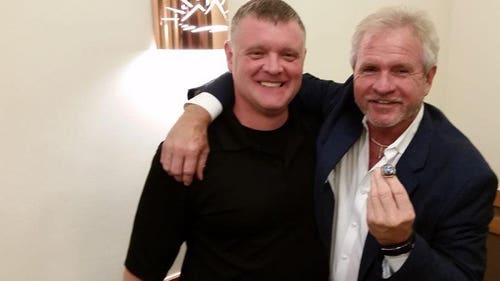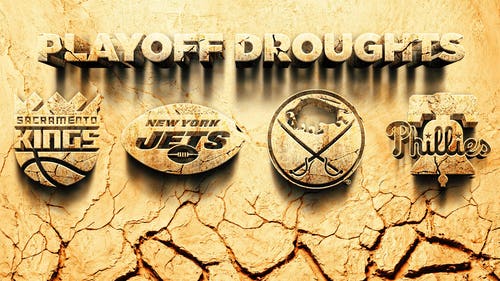
Corbin Carroll is MLB's unconventional, sensational rookie superstar
It's already been a notable week for Arizona Diamondbacks rookie outfielder Corbin Carroll.
Monday morning, Carroll was named National League Player of the Week after hitting .500 with six extra-base hits over Arizona’s undefeated five-game road trip to Washington and Detroit. That evening, Carroll reached base four more times and scored twice in a narrow victory over Philadelphia. On Tuesday, he homered and reached base twice to raise his season-high on-base percentage to .398, his OPS to .998 and his OPS+ to 171, which ranks best among all qualified NL hitters. Carroll has also joined Wander Franco atop the non-Shohei Ohtani fWAR leaderboard.
Most importantly, the D-backs — yes, the D-backs! — have supplanted the Braves for the best record in the NL.
Carroll’s big game on Monday was somewhat lost in the benches-clearing fracas that stemmed from his second hit by pitch of the game when manager Torey Lovullo came out of the dugout fuming that his best player — a 22-year-old rookie batting third nearly every night for a first-place team — was plunked in his first two at-bats. Rather than get in the mud regarding the unwritten rules of what is and isn’t okay when it comes to throwing inside and when managers should and shouldn’t get angry about their players getting hit, let’s skip to Carroll’s third plate appearance.
Facing right-hander Yunior Marte with the tying run on first base, Carroll got a pitch he could do damage on — rather than a pitch that could damage him — and the diminutive star did what he’s done all year: he smoked it.
Carroll’s third triple of the year came off the bat at 104.3 MPH. It was the 35th ball Carroll put in play this season at 104 MPH or harder, tied for the 29th in baseball. That might not sound all that impressive until you realize he ranks ahead of players like Randy Arozarena, Freddie Freeman and Mookie Betts. Raise the bar a bit higher and you’ll find that Carroll’s eight balls in play this year with at least a 109 mph exit velocity are tied with Paul Goldschmidt and Luis Robert. Still not impressed? Carroll’s best bolt on the season — a 113.8 MPH double — puts him in the 92nd percentile for max exit velocity, ahead, if ever so slightly, of feared sluggers like Bryce Harper (113.7 MPH), Pete Alonso (113.4 MPH) and Corey Seager (113.3 MPH).
Just to be clear, we are still talking about the same player who, at 30.2 feet per second, currently ranks fifth in the majors in average sprint speed and third in home-to-first time. Carroll’s wheels are constantly on display on the basepaths and in the outfield. But while the speed has been every bit as advertised, it’s the shocking power Carroll has already shown that has elevated his offensive reputation beyond just a slash-and-dash menace atop the order. That speedy style of play is in his repertoire, surely, but it hardly defines him as a hitter. Carroll, whose 34 extra-base hits are the fifth-most in MLB, is crushing balls consistently.
Listed at 5-foot-10, 165 pounds, Carroll does not jump off the screen physically the way most middle-of-the-order sluggers do. He’s one of just four qualified hitters listed at 165 pounds or lighter alongside Andrés Giménez, Ozzie Albies and Ezequiel Tovar, all three of whom occupy middle infield positions more often associated with smaller players. (José Altuve doesn’t have enough at-bats to qualify, but he is also somewhat hilariously listed at 166 pounds, for what it’s worth.)
Weight listings — which sometimes don’t get updated after a player first signs — should be taken with a grain of salt, and Carroll has certainly packed on some muscle since entering pro ball. Still, he doesn’t look all that dissimilar from when he was tearing up the showcase circuit as a teenager.
Before his senior year at Lakeside School in Seattle, Carroll was rarely the biggest or strongest player on the field but routinely performed as one of the best. If there was a physical trait that stood out, it was his blazing speed. In turn, his speed — and stature — screamed future leadoff hitter for those trying to project Carroll’s game at the next level. His pre-draft report on MLB Pipeline referred to Jacoby Ellsbury and Andrew Benintendi as possible comparisons; lefty outfielders who batted at or near the order as prototypical table-setters.
Those were hardly insults, as both Ellsbury and Benintendi went on to have big-league success and made a whole bunch of money along the way. But these parallels drawn just four years ago also help to highlight what Carroll has already proven capable of at the highest level — and how much better he can still become. Ellsbury’s stolen base totals were consistently sky-high during his prime, but he famously only had one year of sizable power production before declining sharply with the Yankees. Benintendi hit 20 homers and stole 20 bases in 151 games as a 22-year-old rookie in 2017, but he’s struggled to match either of those totals in any season since.
Carroll, meanwhile, has already launched 18 homers and swiped 21 bags through his first 96 career games. His 33 homers + steals this season trail only Ronald Acuña Jr.’s 41, and his recent power surge suggests 30/30 is very much in play. That would put Carroll in some exceptional company as just the fourth player in MLB history to go 30/30 in their age-22 season or younger, alongside Acuña, Álex Rodríguez and Mike Trout. Even if he goes 25/25, Carroll would be one of just 10 players to have accomplished that by this age, joining the likes of Barry Bonds and Andruw Jones to more recent power-speed threats like Fernando Tatís Jr. and Julio Rodríguez.
When names like that start getting tossed around, it’s easy to get caught up in the hype and immediately place MVP-level expectations on Carroll for years to come. If that seems a bit irresponsible — those pre-draft comparisons to Ellsbury or Benintendi clearly don’t do Carroll justice — here’s a fun alternative to consider: How about a guy who, 20 years earlier, played his high school ball just twenty miles north of Carroll’s old Seattle stomping grounds? That’s right: It’s time to remember how ridiculously awesome Grady Sizemore was.
At 6-foot-2, 205 pounds, Sizemore was certainly more physical than Carroll might ever be, but the production at his phenomenal peak — even as a leadoff hitter — looks eerily similar to what we could realistically see from Carroll as he enters his prime. Like Carroll, Sizemore also made his MLB debut within weeks of his 22nd birthday, playing in 43 games in the second half of the 2004 season for Cleveland. Then, from 2005 to 2008, Sizemore hit .281/.372/.496 and averaged 41 doubles, 27 homers and 29 steals a year. He made three All-Star Games, won two Gold Gloves and was roughly a 6-7 WAR player each season. He was an absolute superstar.
As we all know, injuries ultimately ripped away any chance Sizemore had of sustaining this elite career track. We can only hope Carroll’s career comes with far greater injury luck than what Sizemore frustratingly dealt with shortly after his All-Star peak. But from a pure production and play-style standpoint, peak Sizemore would be one hell of an outcome for Carroll. I’d bet on Carroll to end up averaging more steals and fewer homers than Sizemore, but a .280/.370/.500 slash line sure looks like a reasonable seasonal standard for Carroll to aspire to. Of course, if this year’s .313/.398/.599 line is any indication, we might still be underselling Carroll’s potential — and that’s an exciting thought.
Perhaps, Carroll does eventually end up back in the leadoff spot as many envisioned; maybe he’ll bat third for the next decade. As long as he’s hitting this well, no one is going to be too concerned about where Carroll slots in the batting order.
When the D-backs committed to Carroll with an eight-year, $111 million extension in spring training, despite him having only 32 big-league games to his name, it was clear they viewed him as a foundational player to build around. For those who have watched Carroll adjust to and excel at each level of competition since his days at Lakeside, his ascension into superstardom may not be all that surprising on its face. But for it to happen this quickly and for this team as it challenges for an NL West title? You couldn’t see it coming.
Jordan Shusterman is half of @CespedesBBQ and a baseball writer for FOX Sports. He has covered baseball for his entire adult life, most notably for MLB.com, DAZN and The Ringer. He's a Mariners fan living in the Eastern Time Zone, which means he loves a good 10 p.m. first pitch. You can follow him on Twitter @j_shusterman_.









